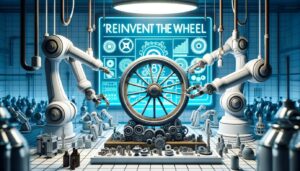Since the 1990s, the Western automotive industry has widely adopted the practices derived from the Toyota production system. 5S, continuous improvement is the daily life of automotive suppliers.Pull flow – formerly known as Just in Time – is at the heart of these practices. It is facilitated by the fact that the automotive upstream supply chain is clocked by the car manufacturers’ assembly lines.
This assembly line task time reduces the variability of demand applied to upstream suppliers through a smoother flow. As soon as carmakers generate a stabilized demand signal, centered on high volumes of standardized parts for local suppliers, upstream players can optimize their flows to pace their own operations at the speed of assembly lines and limit stocks to what is strictly necessary.
To orchestrate these flows, automotive suppliers have implemented and sophisticated Kanban techniques imported from Japan, replenishment loops that react to the actual customer consumption. Loops whose sizes are adjusted each week according to changes in demand, sequencers (heijunka box) to smooth the load and optimize mixed model scheduling, flow line manufacturing, design of industrial processes according to Lean principles: no industry has gone so far in deploying pull flow techniques.
In this context, optimized over the past decades it was not clear that DDMRP would be making much difference. What is the significant difference between a DDMRP buffer and a dynamically adjusted Kanban system loop?
However, players in the sector who had developed highly successful pull flow systems, such as our customers Michelin and Aptiv, testify to further optimizations, with stock reductions of 10-15% or more and improved service, after DDMRP implementation.
How can this be explained?
A tentative explanation is that car manufacturers are less and less able to generate this “stabilized demand signal, centered on high volumes of standardized parts for local suppliers” mentioned above.
Today’s automotive supply chain is far more complex than it was in the 90s or 2000s when Lean techniques were rolled out in occident. Some hints:
- Vehicles are becoming more and more complex and have more and more components. In the 90s there was hardly any electronics in a vehicle: a car radio, the oldest among us remember the innovation of electronic injection… The embedded computing power and the number of microprocessors in any small car today would probably have been the equivalent of a datacenter 20 years ago. Studies show that 40% of the cost of a vehicle is in electronics.
- Supply Chains have become more complex and longer. Formerly centered on a local supplier base, this industry has strongly relocated to countries with low labor costs, leading to longer lead times and additional disruption risks.
- The customization of vehicles, as well as the proliferation of vehicle models, leads to more options and variants, and therefore more volatile requirements on a wider range of components.
- Technological innovations and disruptions are being introduced faster and faster – from infotainment features to electric vehicles and autonomous driving.
- Beyond OEM, the aftermarket segment is increasingly competitive and complex.
All these factors stress test the “old-fashioned” pull flow: Kanban loops work well in a stable environment, but have difficulties adapting when variability increases.
The Future of the Automotive Supply Chain
Although the car OEM demand from car manufacturers is less variable than in other industries directly connected to end customers, analysis of the fluctuations in OEM EDI requirements sent to Tier 1 shows significant ups and downs week over week – due to the increased diversity of components, but also to the fact that these signals are mostly generated via conventional MRP logic derived from the assembly line MPS. When looking at the demand signals seen by Tier 2 and Tier 3 suppliers, the bullwhip effect is often devastating!
Furthermore, aftermarket supply chain management has often remained aloof from pull-flow techniques, and is often based on classic DRP logic, which is well known to generate major bullwhip effects.
Generalization of a digitalized dynamic pull flow replenishment for all suppliers, reduction of the risks of disruption by adapted sizing of buffers and structured prioritization of execution, continuous improvement of replenishment loops, complete integration of pull flow and ERP systems, absorption of variability from the aftermarket distribution network: these are just some of the DDMRP functionalities used by the automotive companies that have adopted it.
The most advanced practitioners combine tactics from Theory of Constraints and Lean, through the implementation of a full demand driven operating model (DDOM). Heijunka boards and physical launchers, which are difficult to maintain when the number of items increases, are replaced by constraint scheduling and the visual management of time buffers thanks to the digitalization of the Drum Buffer Rope approach.
Pull flow has enabled the survival and development of the Western automotive industry over the past decades – it’s time to take it to the next level with the adoption of Demand Driven tactics!
Learn more about DDMRP in the automotive industry by contacting us.












